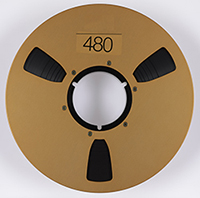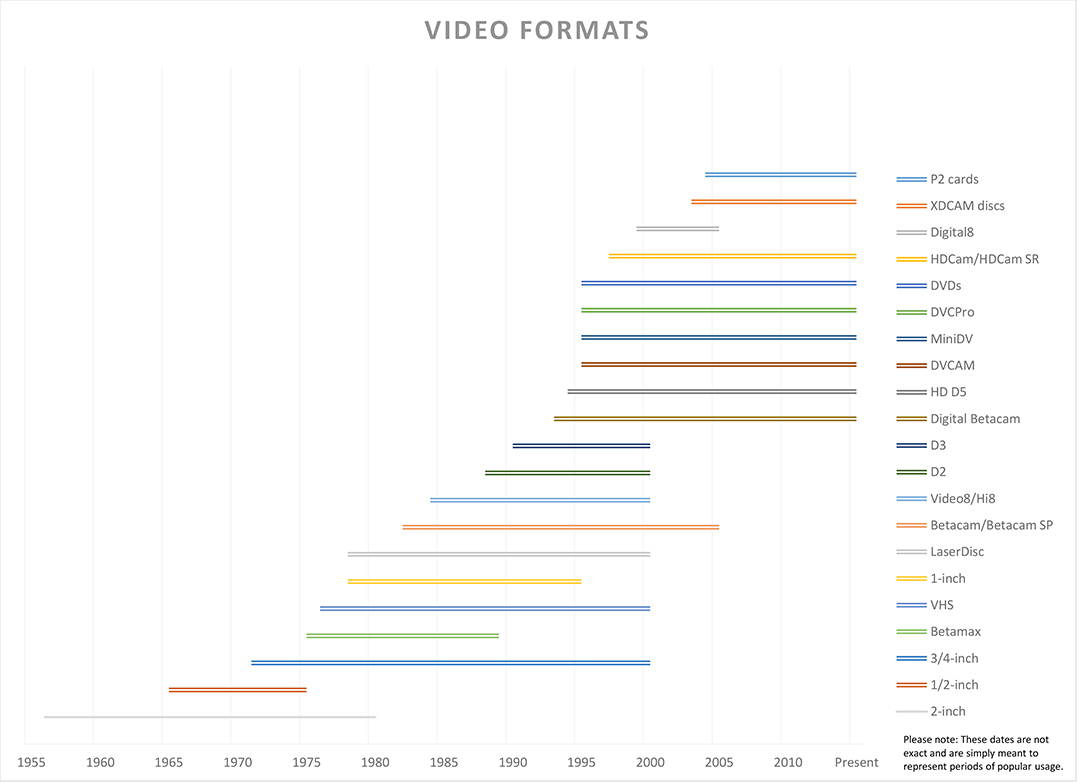
Video Guidance: Identifying Video Formats
How Do I Identify Video Formats?
Video formats come in a variety of shapes and sizes and have been available commercially since 1956. You may come across video in the form of heavy 2-inch tapes that are stored in specialized containers or you may find video saved on small flash cards the size of a postage stamp. Sometimes your video will have identifying markings from the manufacturer or the content creator. If you do not have these helpful markings, you can follow some of the guidelines below to determine what type of video you may have.
Magnetic Tape
Open Reel Video
One easy way to determine what type of magnetic videotape you might have is to note whether it is stored on an open reel or inside a cassette. This will help you to significantly narrow down the type of tape you may have encountered. There are only four different widths of open reel videotape: 2-inch, 1-inch, ½ -inch, and ¼ -inch.
- 2-inch tapes usually date from the 1960s to 1970s while 1-inch was prevalent during the 1980s to 1990s; both formats were typically used in a broadcast or studio recording setting.
- ½ -inch tapes were a little less common and were used by smaller organizations or even consumers primarily during the 1970s to 1980s.
- ¼ -inch video tapes are uncommon, though a few formats existed between the late 1960s and early 1970s.
Measure the width of the tape to determine which of these four sizes you have. Always exercise care when handling magnetic tape– ideally some leader or blank tape will be present and you will not need to touch the part of the tape containing content.
Remember that just because you have determined the physical format of the tape, you still don’t know what has been recorded on the tape. As noted in identifying audio formats, 1-inch and 2-inch tape were also used in professional audio recording so it is possible to have audio only on these larger open reel tape formats.
Video Cassettes
If you have cassette-based videotape then there are many more possibilities.
- The earliest type of video cassette was an analog format called ¾ -inch or U-matic. These cassettes came in two sizes: regular and small or ‘S’ cassettes. U-matic tapes were a common broadcast or edit mastering format in the 1970s - 1980s; they were also used in the educational and industrial markets.
- The early consumer cassette tapes dated from the late 1970s to1990s and included VHS and Betamax. These two formats were famously locked in a format war which VHS eventually won.
- During the 1980s, the professional Betacam formats were introduced as well, these included Betacam and BetacamSP.
- Later in the 1990s Betacam SX and Digital Betacam (both digital formats) became prevalent. The Betacam SP and Digital Betacam formats have been (and in some cases still are) used as mastering formats in both broadcast and preservation settings.
- Lesser-known professional formats like D1 and D2 were used for mastering as well. These were also high-quality digital tape formats, but they did not become as popular.
- Video8, Hi-8 and Digital8 were the first small video cassette formats. These were popular in both professional and consumer markets and could easily be used in camcorders.
- More modern cassette formats include DVCPro, DVCam and miniDV. These formats are also small and portable. HDCam is a larger, more robust modern cassette format that is sometimes used for mastering or making intermediate copies of film content.
Optical Discs
Video can also be stored on optical discs. These include well-known formats like DVD and Blu-Ray discs as well as the older and less common LaserDisc format. LaserDiscs are much larger than DVDs, typically measuring 12 inches across; DVDs are typically 4.65 inches across. Smaller versions of both formats exist, but are less common.
What are the different video systems in the world?
Even if you have identified the physical features of a video tape, you may still need to determine which type of video standard is recorded on the tape in order to ensure that it plays back properly.
If you have analog composite video recordings, they are recorded in one of three major video encoding systems that exist in the world.
These systems were developed as a means of combining in one signal all the information necessary to broadcast, display, and record video. Although each has a large number of sub variations, the three systems are:
- NTSC (National Television System Committee)
- PAL (Phase Alternate Line)
- SECAM (Séquentiel couleur à mémoire)
Countries and regions throughout the world have at various points in time, and sometimes for geopolitical reasons, adopted one of these analog standards. NTSC is the standard that was adopted within North and Central America and all countries in the Caribbean except Guadeloupe and Martinique.
The various systems are not compatible, so it is important to be aware of this if you are trying to playback or transfer your recordings. If you have analog recordings from another country or region of the world you will need to ensure that the playback machine is either the same system as the recording you have or capable of playing back multiple systems. Depending on the output options of your player, you may also need to have the output standard converted. Commercial standards converters are available for purchase, and some service providers provide those services.
This is a map showing where the various video encoding systems are used.
Where can I find more information?
Magnetic Tape
- Videotape Identification and Assessment Guide From the Texas Commission on the Arts
Optical Discs
- Care and Handling of CDs and DVDs By Fred R. Byers, published by Council on Library and Information Resources (CLIR)
PDF files require the free Adobe Reader.
More information on Adobe Acrobat PDF files is available on our Accessibility page.
 One-inch tape
One-inch tape Betacam SC
Betacam SC Laser-disc
Laser-disc Two-inch tape
Two-inch tape Open-reel half-inch tape
Open-reel half-inch tape VHS
VHS Mini-DV
Mini-DV Hi-8
Hi-8 Digibeta
Digibeta Betamax
Betamax U-matic
U-matic DVD
DVD